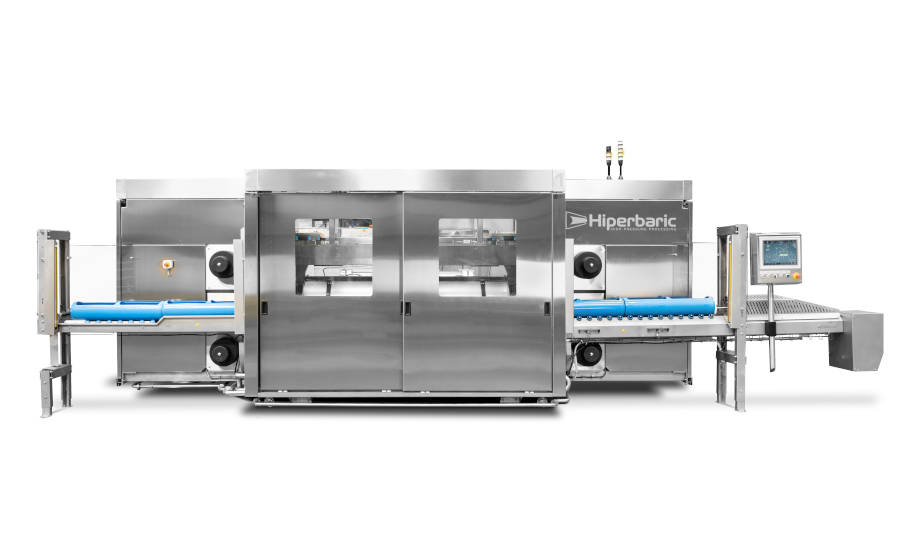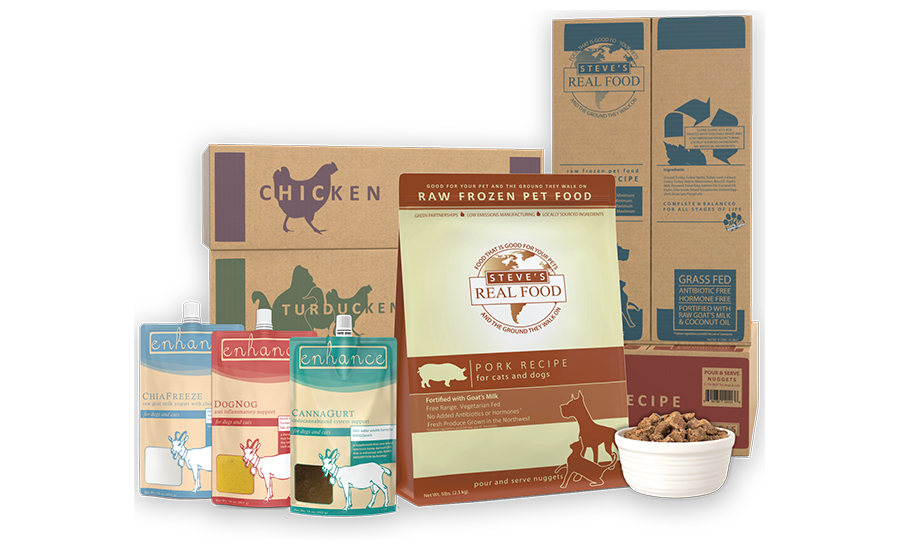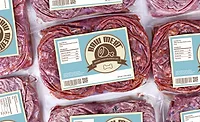Raw & Fresh Pet Food Processing
Raw pet food: hype or healthy? Part 2
Raw pet food is processed only one way, but that has proven to be the right way

Photo courtesy of Getty Images/Zontica
The raw pet food segment is expected to continue growing as it has for the past decade. Consumers are attracted to this pet diet due to the products being free from preservatives, synthetic additives, grains, fillers and any meat by-products. Raw pet food contains high-quality meat and vegetables. It is immediately frozen after it is prepared, which preserves its freshness. Easy for consumers to feed and offering peace of mind, pet parents around the world are pushing the segment to new heights.
To understand how raw pet food is processed differently than dry kibble and other types of pet products, Hiperbaric—along with its customer Steve’s Real Food—discuss the processing method they go through to get product out the door. Hiperbaric offers high pressure processing (HPP), a non-thermal preservation technology that meets the high-standard requirements of consumers and manufacturers of the pet food industry. It eliminates harmful and spoilage microorganisms by holding the products under high hydrostatic pressure (4,000-6,000 bar / 400-600 MPa / 58,000-87,000 psi). Therefore, it reduces or eliminates the need for chemical preservatives.
Hiperbaric and Steve’s Real Food
Roberto Peregrina, director at Hiperbaric USA, shares that freeze-dried raw formulas and treats are stable at room temperature but nutritionally equivalent to frozen raw formulas.
HPP preserves the fresh attributes of the products up to a few months when refrigerated. As stated above, raw food is usually prepared by HPP, and then frozen or freeze dried. Peregrina adds that it is possible to launch refrigerated product with shorter shelf life as well.

According to the report “Guidance for the Raw Food Pet Industry” by Hiperbaric, in preparation for HPP, the meat or muscle of a dead animal is sterile but susceptible to cross-contamination by E. coli, salmonella, Listeria monocytogenes and other pathogens during slaughter and/or other operations (i.e. grinding) if it touches other organs or contacts contaminated surfaces.
In fact, the FDA Center for Veterinary Medicine (CVM) conducted a study that comprised over 1,000 samples, reporting that Salmonella and Listeria monocytogenes were more prevalent in raw pet food (present in c.a. 16 % of the tested food) than other forms of foods. In addition to bacteria, raw meat may present viruses or parasites such as worms that may not be visible or barely visible to the human eye.
Although pets can be more tolerant to some bacteria, they are not completely immune. Furthermore, foodborne pathogen transmission from pet to owner is possible through the pet’s mouth, fur, skin or any body parts in touch with contaminated saliva or feces. Additionally, the owner may inadvertently spread pathogens in kitchen surfaces or appliances by handling the raw pet food, risking cross-contamination if not properly sanitized.
Therefore, both the Center for Disease Control (CDC) and the FDA have multiple resources to communicate to consumers about the risks of unprocessed meat diets (see Appendix A). Pet food processors also jeopardize pet and pet owner safety, along with brand trust and economic losses, if the potential presence of pathogens in pet food mandates a recall.
In addition to food safety, HPP extends shelf life by slowing down the growth of spoilage microorganisms like yeasts and molds. This achieves between 14 to 35 days of shelf life in refrigerated storage, compared to 7-10 days of unprocessed products.
Bacteria and other microorganisms adapt to different unfavorable environments and might survive freezing, freeze-drying or fermentation. Applying HPP acts as a “kill step” for foodborne pathogens, and the combination with other hurdles like cold storage (refrigeration, freezing) or freeze-drying further minimizes the risk and extends shelf life. For example, the combination of HPP and freezing yields up to two years of shelf life. Freeze-drying achieves up to 2 years but makes the HPP pet food stable for ambient temperature storage.
The fermentation process modifies and acidifies a food product to provide a new sensory experience, just like the fermentation process where bacteria turn milk into cheese. Nonetheless, bacteria will continue to ferment the product until it spoils the food if the product is not properly handled. Pathogens are also able to survive the fermentation process, and an example is that numerous foodborne illness cases occur every year due to the consumption of raw cheese. Applying HPP reduces pathogen loads and stops fermentation, extending the shelf life of foods to 30-75 days.
On the other hand, HPP also has limitations as any other food processing technology that may be complemented by any of the previously discussed pet food operations. For example, spores may survive HPP, some of which are foodborne pathogens. Freezing lowers the temperature, freeze-drying takes away water resources needed for growth, whereas fermentation acidifies the food, yielding conditions not favorable for growth and forcing spore-forming pathogens to remain hidden inside the spore.
Real deal
Steve’s Real Food of Cottonwood, Utah, was the first commercial raw brand on the market in 1998, and since then, has worked to create the “perfect” raw pet food diet. All five of Steve’s Real Food raw meat diets use grass-fed meats and antibiotic-free poultry. The company sources their produce locally to ensure quality and reduce its carbon footprint. Their products are sold in independent retailers nationwide and the company has expanded into international markets with implementation of high pressure processing (HPP).
Prior to HPP, Steve’s Real Food was looking for a way to keep its food safe while maintaining the natural ingredients in raw pet food. The company experimented with many “kill” steps to eliminate foodborne pathogens. They tested acid sprays, biophages, test and hold, probiotic sprays and environmental controls. “These were effective methods but none of them could produce a 5-log reduction which is what our goal was. After working with Hiperbaric, we were able to fine-tune our HPP process to achieve the 5-log reduction, complete a validation study and ensure the food was not nutritionally compromised,” said Nicole Lindsley, owner of Steve’s Pet Food.
The pet food manufacturer started exploring HPP with Hiperbaric two years ago when it became necessary to have validated kill steps to adhere to the Food and Drug Administration (FDA)’s zero-tolerance policy for foodborne bacteria in raw pet food. They conducted extensive research and tested the nutritional makeup of pre- and post-HPP food. A year later, they determined there was not a significant degradation to the food, a common misconception among retailers and consumers. They began using HPP on their poultry products to test the market’s response to the change.

“After another year of research, we discovered that not only would HPP allow us to mitigate the harmful microbial environment but it would also allow us to preserve the food without chemicals and with extended shelf life,” says Nicole Lindsley, owner of Steve’s Pet Food. “This is why we decided to use HPP.”
For its product processing, Steve’s Real Food uses Raw Advantage Processing, an HPP toller that uses the Hiperbaric 55 machine to HPP its raw pet food.
Future of Raw
The raw segment of the pet food industry is only increasing in growth. “HPP will ensure the growth of the raw pet food sector, as more consumers and retailers are educated about it,” Lindsley said. “As they become more knowledgeable, more pet owners will try raw pet food knowing that with HPP it is safe, nutritional and free of pathogens.”
JBT Avure’s Raghubeer adds that it is definitely a growing market, “but we are not sure of the actual growth rate. Pet food manufacturers are increasingly turning to HPP to ensure product safety and expand market opportunities.”
He adds that technology has improved and availability of machines have improved, which has driven down equipment cost. “Tolling requires more cost and buying your own equipment gradually decreases cost. As tolling business increases, they can negotiate cheaper costs. With this, the product cost at-shelf will decrease.
Looking for a reprint of this article?
From high-res PDFs to custom plaques, order your copy today!









